HRM Report: Analysis of Tiered Pay Systems and Employee Fairness
VerifiedAdded on 2022/11/16
|12
|3364
|157
Report
AI Summary
This report examines the concept of tiered pay systems, also known as banded pay, within the context of Human Resource Management (HRM). It defines tiered pay as a wage structure differentiating salaries based on time of hire and performance, primarily aimed at controlling labor costs. The report discusses the effectiveness of such systems, highlighting both short-term and long-term cost reductions for businesses, alongside the potential for workforce division and employee discontent. It then delves into the relevance of tiered pay systems with employee fairness and motivation, focusing on the perceived injustices towards new employees and the potential for legal issues related to equal pay and fair representation by unions. The report analyzes the external and internal factors affecting employee motivation within these systems, concluding with recommendations to address the challenges and ensure fairness in the workplace. This analysis underscores the complexities of tiered pay systems and their impact on both organizational efficiency and employee well-being.
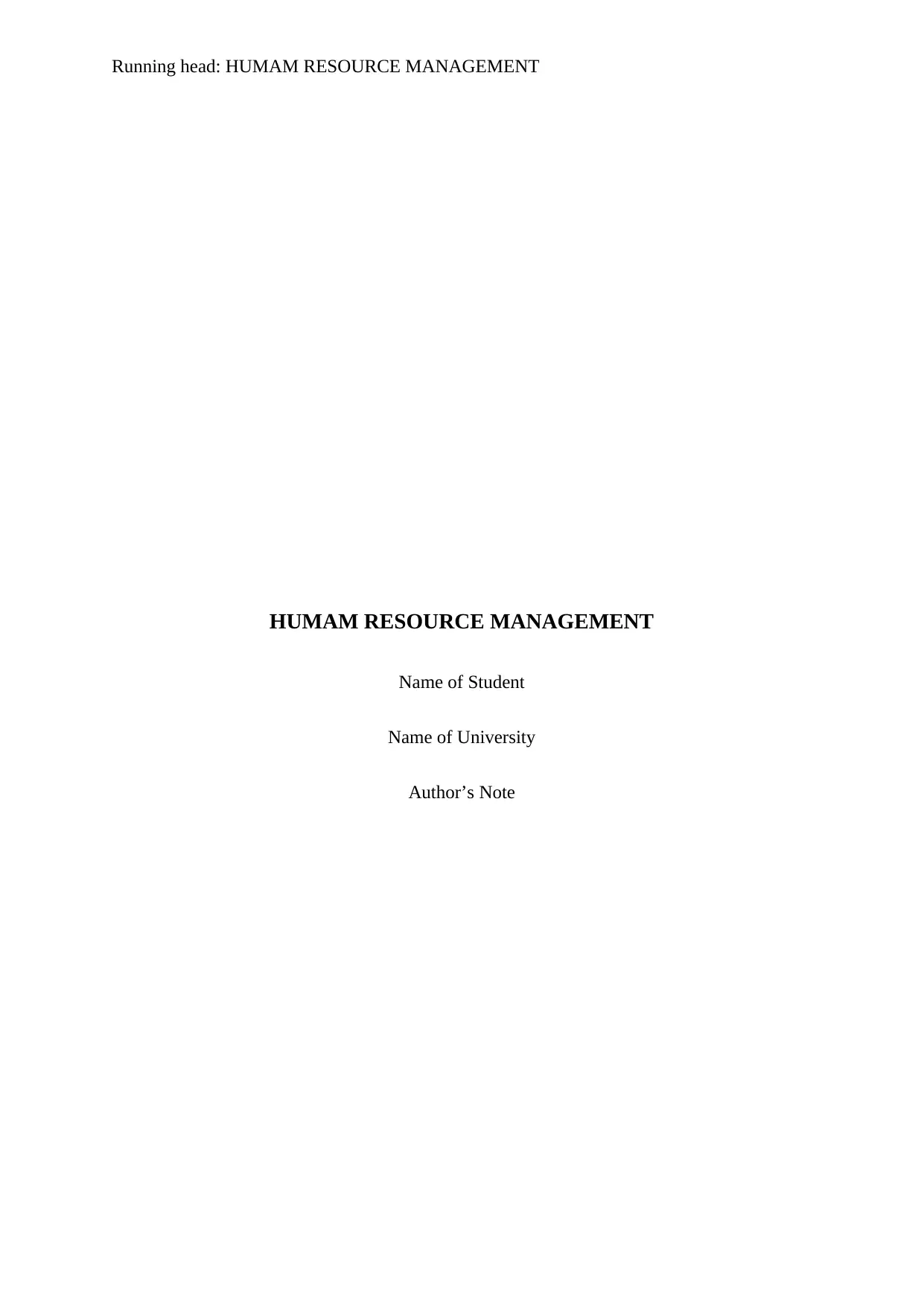
Running head: HUMAM RESOURCE MANAGEMENT
HUMAM RESOURCE MANAGEMENT
Name of Student
Name of University
Author’s Note
HUMAM RESOURCE MANAGEMENT
Name of Student
Name of University
Author’s Note
Paraphrase This Document
Need a fresh take? Get an instant paraphrase of this document with our AI Paraphraser
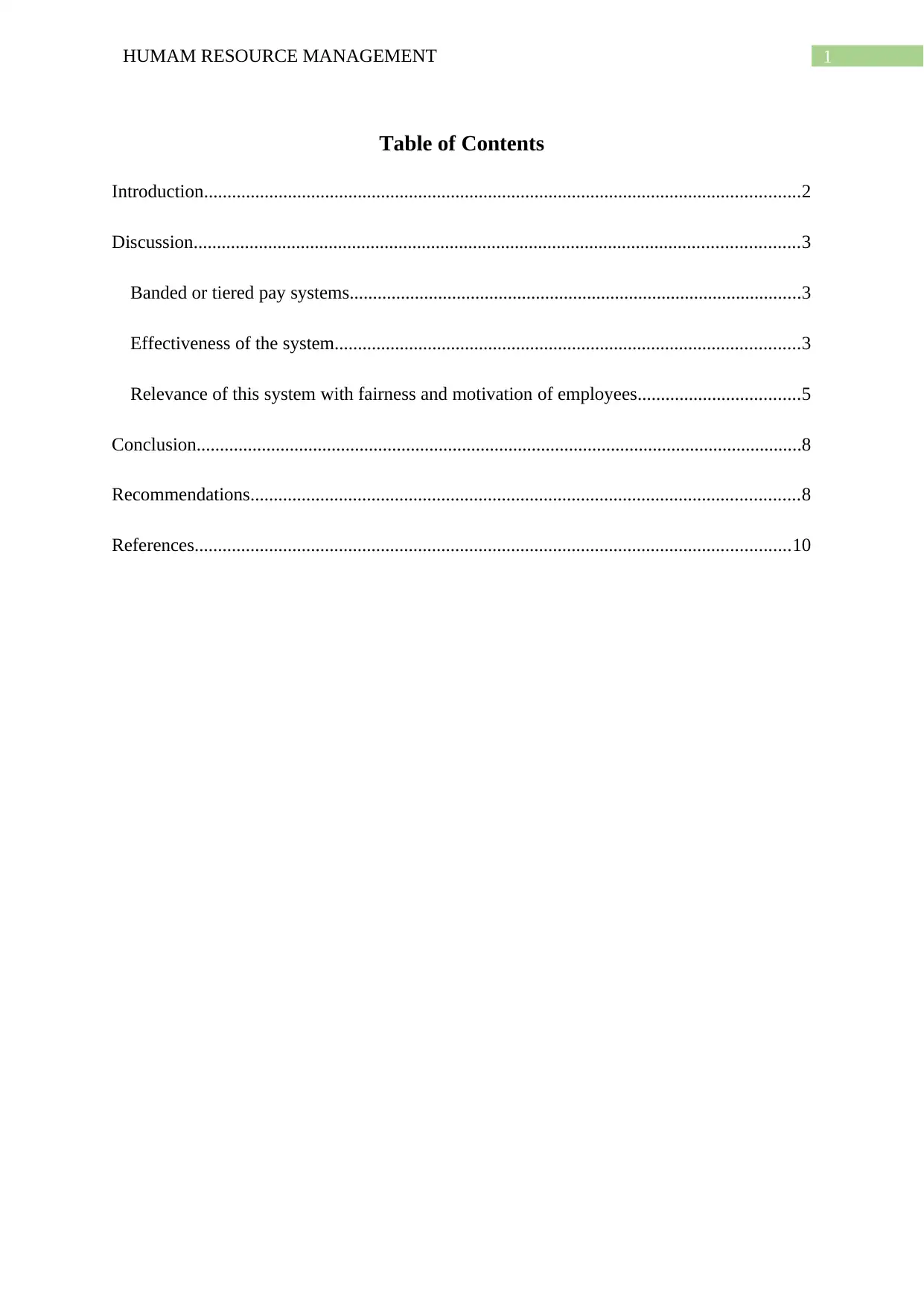
1HUMAM RESOURCE MANAGEMENT
Table of Contents
Introduction................................................................................................................................2
Discussion..................................................................................................................................3
Banded or tiered pay systems.................................................................................................3
Effectiveness of the system....................................................................................................3
Relevance of this system with fairness and motivation of employees...................................5
Conclusion..................................................................................................................................8
Recommendations......................................................................................................................8
References................................................................................................................................10
Table of Contents
Introduction................................................................................................................................2
Discussion..................................................................................................................................3
Banded or tiered pay systems.................................................................................................3
Effectiveness of the system....................................................................................................3
Relevance of this system with fairness and motivation of employees...................................5
Conclusion..................................................................................................................................8
Recommendations......................................................................................................................8
References................................................................................................................................10
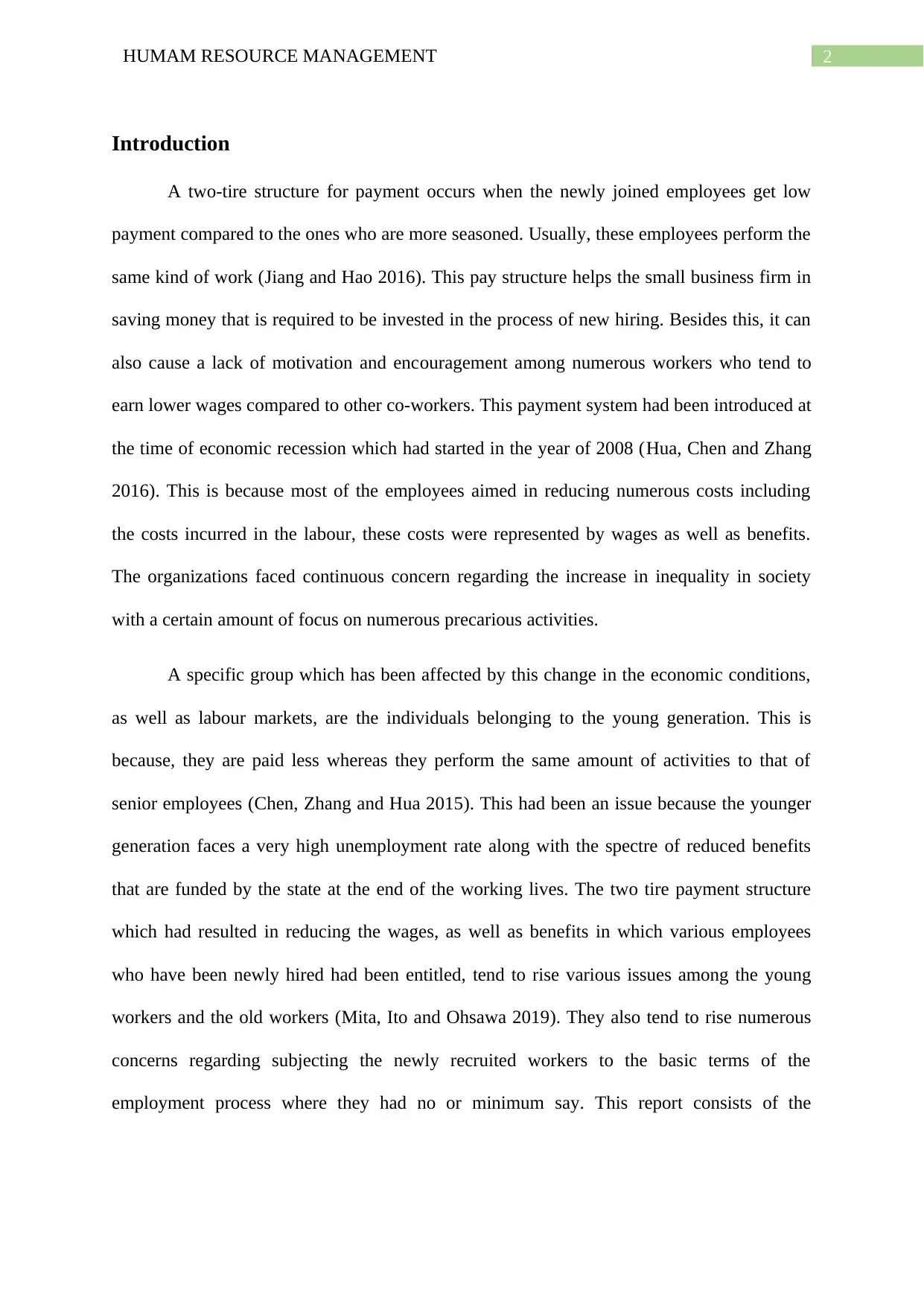
2HUMAM RESOURCE MANAGEMENT
Introduction
A two-tire structure for payment occurs when the newly joined employees get low
payment compared to the ones who are more seasoned. Usually, these employees perform the
same kind of work (Jiang and Hao 2016). This pay structure helps the small business firm in
saving money that is required to be invested in the process of new hiring. Besides this, it can
also cause a lack of motivation and encouragement among numerous workers who tend to
earn lower wages compared to other co-workers. This payment system had been introduced at
the time of economic recession which had started in the year of 2008 (Hua, Chen and Zhang
2016). This is because most of the employees aimed in reducing numerous costs including
the costs incurred in the labour, these costs were represented by wages as well as benefits.
The organizations faced continuous concern regarding the increase in inequality in society
with a certain amount of focus on numerous precarious activities.
A specific group which has been affected by this change in the economic conditions,
as well as labour markets, are the individuals belonging to the young generation. This is
because, they are paid less whereas they perform the same amount of activities to that of
senior employees (Chen, Zhang and Hua 2015). This had been an issue because the younger
generation faces a very high unemployment rate along with the spectre of reduced benefits
that are funded by the state at the end of the working lives. The two tire payment structure
which had resulted in reducing the wages, as well as benefits in which various employees
who have been newly hired had been entitled, tend to rise various issues among the young
workers and the old workers (Mita, Ito and Ohsawa 2019). They also tend to rise numerous
concerns regarding subjecting the newly recruited workers to the basic terms of the
employment process where they had no or minimum say. This report consists of the
Introduction
A two-tire structure for payment occurs when the newly joined employees get low
payment compared to the ones who are more seasoned. Usually, these employees perform the
same kind of work (Jiang and Hao 2016). This pay structure helps the small business firm in
saving money that is required to be invested in the process of new hiring. Besides this, it can
also cause a lack of motivation and encouragement among numerous workers who tend to
earn lower wages compared to other co-workers. This payment system had been introduced at
the time of economic recession which had started in the year of 2008 (Hua, Chen and Zhang
2016). This is because most of the employees aimed in reducing numerous costs including
the costs incurred in the labour, these costs were represented by wages as well as benefits.
The organizations faced continuous concern regarding the increase in inequality in society
with a certain amount of focus on numerous precarious activities.
A specific group which has been affected by this change in the economic conditions,
as well as labour markets, are the individuals belonging to the young generation. This is
because, they are paid less whereas they perform the same amount of activities to that of
senior employees (Chen, Zhang and Hua 2015). This had been an issue because the younger
generation faces a very high unemployment rate along with the spectre of reduced benefits
that are funded by the state at the end of the working lives. The two tire payment structure
which had resulted in reducing the wages, as well as benefits in which various employees
who have been newly hired had been entitled, tend to rise various issues among the young
workers and the old workers (Mita, Ito and Ohsawa 2019). They also tend to rise numerous
concerns regarding subjecting the newly recruited workers to the basic terms of the
employment process where they had no or minimum say. This report consists of the
⊘ This is a preview!⊘
Do you want full access?
Subscribe today to unlock all pages.

Trusted by 1+ million students worldwide
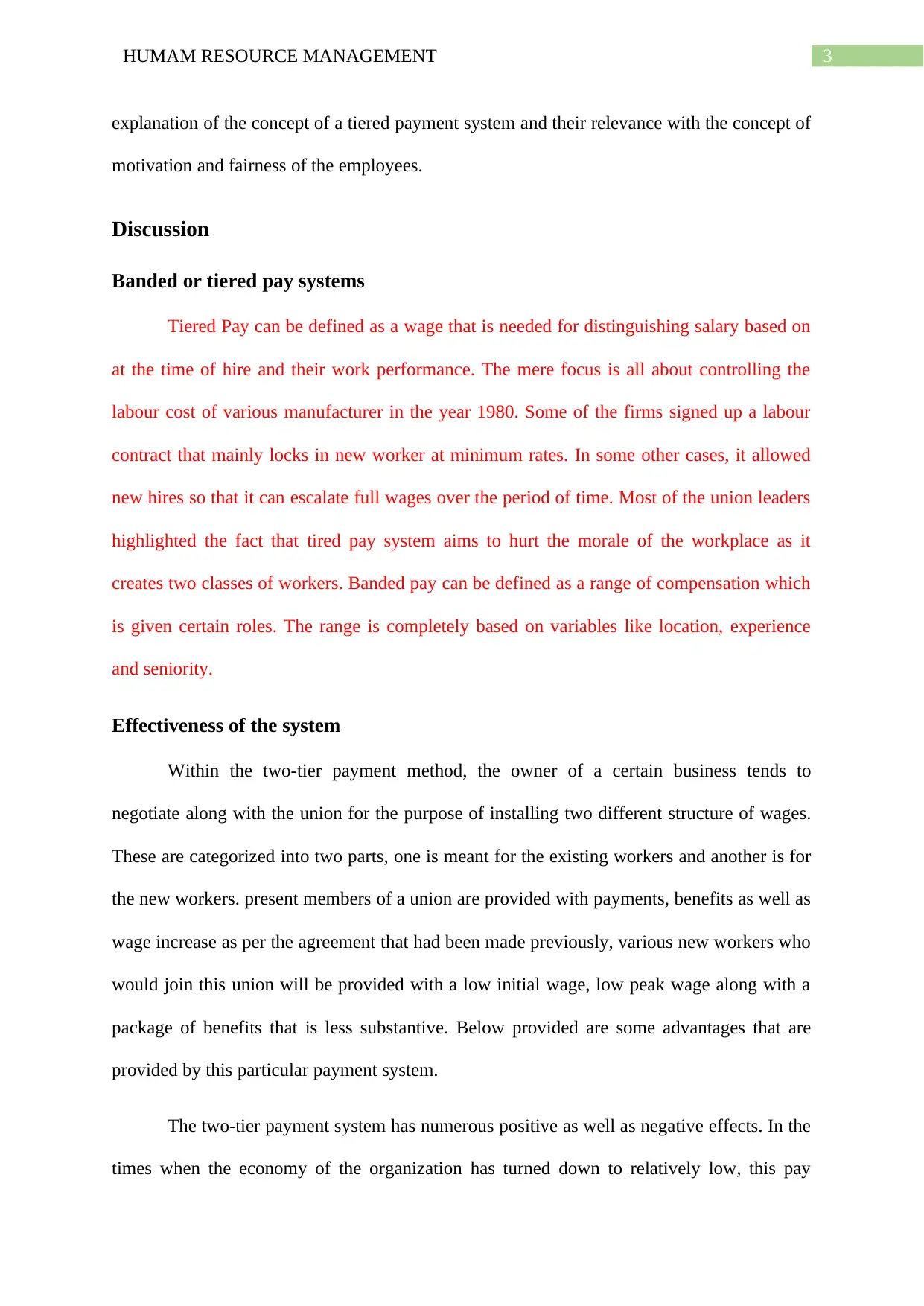
3HUMAM RESOURCE MANAGEMENT
explanation of the concept of a tiered payment system and their relevance with the concept of
motivation and fairness of the employees.
Discussion
Banded or tiered pay systems
Tiered Pay can be defined as a wage that is needed for distinguishing salary based on
at the time of hire and their work performance. The mere focus is all about controlling the
labour cost of various manufacturer in the year 1980. Some of the firms signed up a labour
contract that mainly locks in new worker at minimum rates. In some other cases, it allowed
new hires so that it can escalate full wages over the period of time. Most of the union leaders
highlighted the fact that tired pay system aims to hurt the morale of the workplace as it
creates two classes of workers. Banded pay can be defined as a range of compensation which
is given certain roles. The range is completely based on variables like location, experience
and seniority.
Effectiveness of the system
Within the two-tier payment method, the owner of a certain business tends to
negotiate along with the union for the purpose of installing two different structure of wages.
These are categorized into two parts, one is meant for the existing workers and another is for
the new workers. present members of a union are provided with payments, benefits as well as
wage increase as per the agreement that had been made previously, various new workers who
would join this union will be provided with a low initial wage, low peak wage along with a
package of benefits that is less substantive. Below provided are some advantages that are
provided by this particular payment system.
The two-tier payment system has numerous positive as well as negative effects. In the
times when the economy of the organization has turned down to relatively low, this pay
explanation of the concept of a tiered payment system and their relevance with the concept of
motivation and fairness of the employees.
Discussion
Banded or tiered pay systems
Tiered Pay can be defined as a wage that is needed for distinguishing salary based on
at the time of hire and their work performance. The mere focus is all about controlling the
labour cost of various manufacturer in the year 1980. Some of the firms signed up a labour
contract that mainly locks in new worker at minimum rates. In some other cases, it allowed
new hires so that it can escalate full wages over the period of time. Most of the union leaders
highlighted the fact that tired pay system aims to hurt the morale of the workplace as it
creates two classes of workers. Banded pay can be defined as a range of compensation which
is given certain roles. The range is completely based on variables like location, experience
and seniority.
Effectiveness of the system
Within the two-tier payment method, the owner of a certain business tends to
negotiate along with the union for the purpose of installing two different structure of wages.
These are categorized into two parts, one is meant for the existing workers and another is for
the new workers. present members of a union are provided with payments, benefits as well as
wage increase as per the agreement that had been made previously, various new workers who
would join this union will be provided with a low initial wage, low peak wage along with a
package of benefits that is less substantive. Below provided are some advantages that are
provided by this particular payment system.
The two-tier payment system has numerous positive as well as negative effects. In the
times when the economy of the organization has turned down to relatively low, this pay
Paraphrase This Document
Need a fresh take? Get an instant paraphrase of this document with our AI Paraphraser
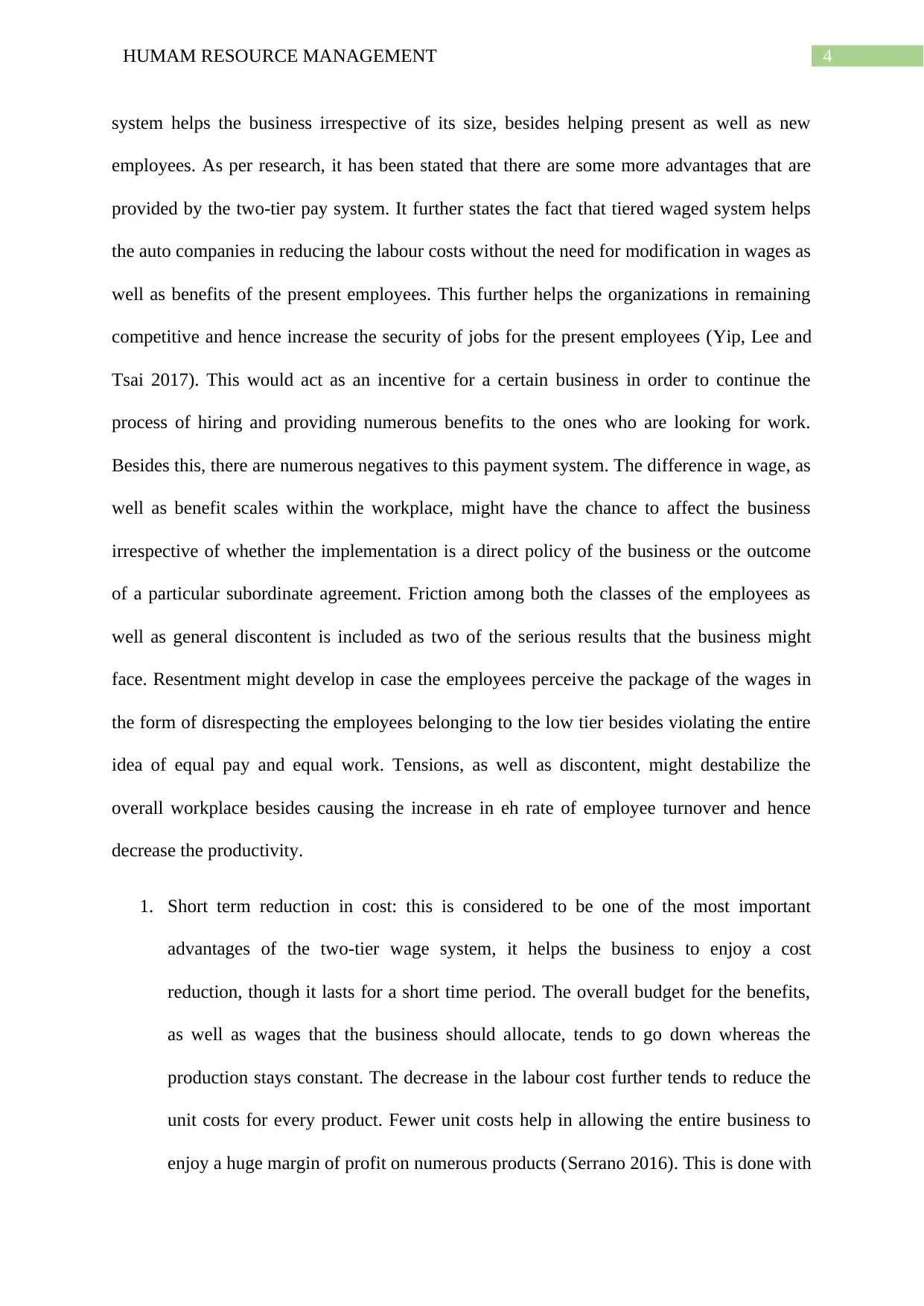
4HUMAM RESOURCE MANAGEMENT
system helps the business irrespective of its size, besides helping present as well as new
employees. As per research, it has been stated that there are some more advantages that are
provided by the two-tier pay system. It further states the fact that tiered waged system helps
the auto companies in reducing the labour costs without the need for modification in wages as
well as benefits of the present employees. This further helps the organizations in remaining
competitive and hence increase the security of jobs for the present employees (Yip, Lee and
Tsai 2017). This would act as an incentive for a certain business in order to continue the
process of hiring and providing numerous benefits to the ones who are looking for work.
Besides this, there are numerous negatives to this payment system. The difference in wage, as
well as benefit scales within the workplace, might have the chance to affect the business
irrespective of whether the implementation is a direct policy of the business or the outcome
of a particular subordinate agreement. Friction among both the classes of the employees as
well as general discontent is included as two of the serious results that the business might
face. Resentment might develop in case the employees perceive the package of the wages in
the form of disrespecting the employees belonging to the low tier besides violating the entire
idea of equal pay and equal work. Tensions, as well as discontent, might destabilize the
overall workplace besides causing the increase in eh rate of employee turnover and hence
decrease the productivity.
1. Short term reduction in cost: this is considered to be one of the most important
advantages of the two-tier wage system, it helps the business to enjoy a cost
reduction, though it lasts for a short time period. The overall budget for the benefits,
as well as wages that the business should allocate, tends to go down whereas the
production stays constant. The decrease in the labour cost further tends to reduce the
unit costs for every product. Fewer unit costs help in allowing the entire business to
enjoy a huge margin of profit on numerous products (Serrano 2016). This is done with
system helps the business irrespective of its size, besides helping present as well as new
employees. As per research, it has been stated that there are some more advantages that are
provided by the two-tier pay system. It further states the fact that tiered waged system helps
the auto companies in reducing the labour costs without the need for modification in wages as
well as benefits of the present employees. This further helps the organizations in remaining
competitive and hence increase the security of jobs for the present employees (Yip, Lee and
Tsai 2017). This would act as an incentive for a certain business in order to continue the
process of hiring and providing numerous benefits to the ones who are looking for work.
Besides this, there are numerous negatives to this payment system. The difference in wage, as
well as benefit scales within the workplace, might have the chance to affect the business
irrespective of whether the implementation is a direct policy of the business or the outcome
of a particular subordinate agreement. Friction among both the classes of the employees as
well as general discontent is included as two of the serious results that the business might
face. Resentment might develop in case the employees perceive the package of the wages in
the form of disrespecting the employees belonging to the low tier besides violating the entire
idea of equal pay and equal work. Tensions, as well as discontent, might destabilize the
overall workplace besides causing the increase in eh rate of employee turnover and hence
decrease the productivity.
1. Short term reduction in cost: this is considered to be one of the most important
advantages of the two-tier wage system, it helps the business to enjoy a cost
reduction, though it lasts for a short time period. The overall budget for the benefits,
as well as wages that the business should allocate, tends to go down whereas the
production stays constant. The decrease in the labour cost further tends to reduce the
unit costs for every product. Fewer unit costs help in allowing the entire business to
enjoy a huge margin of profit on numerous products (Serrano 2016). This is done with
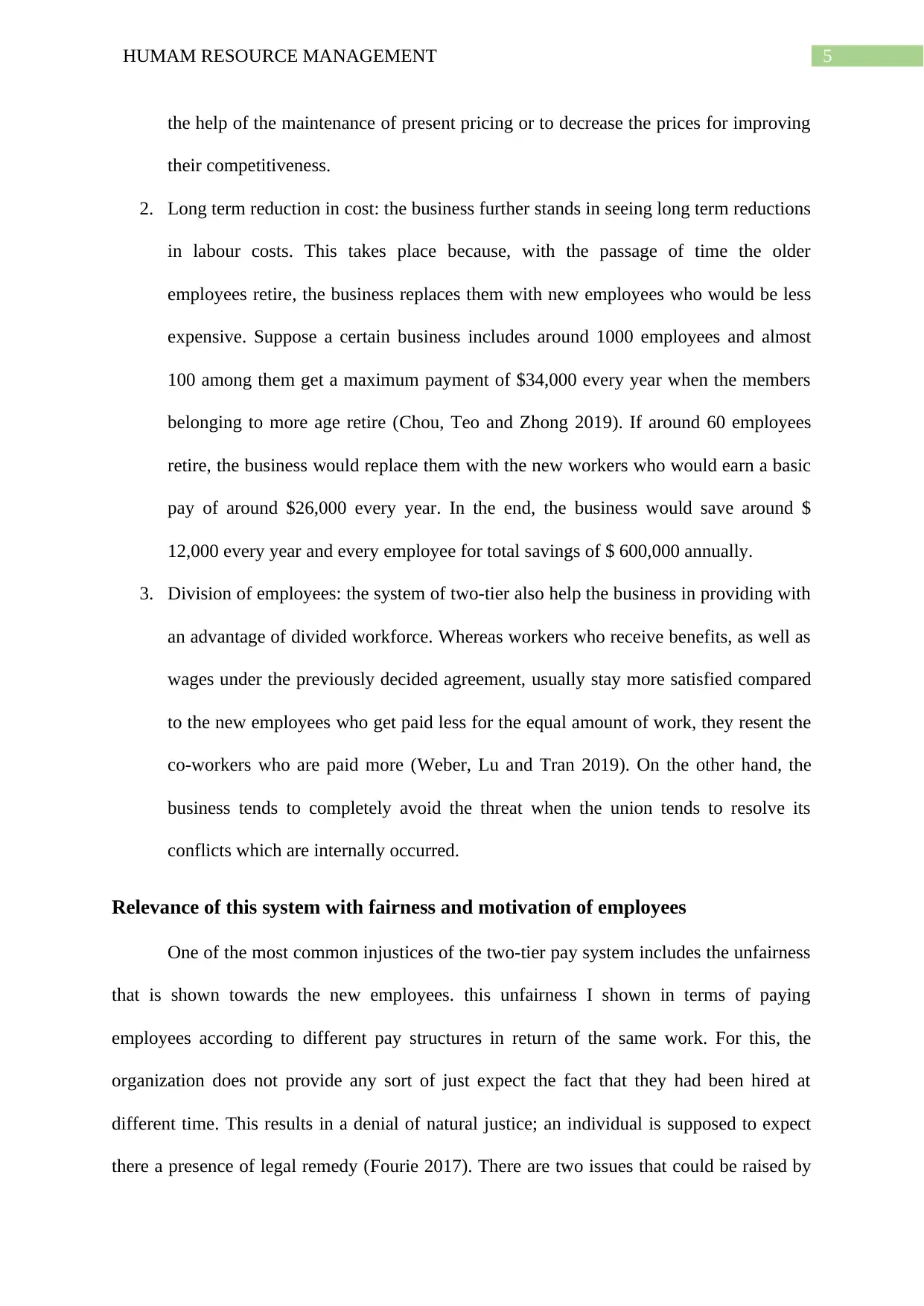
5HUMAM RESOURCE MANAGEMENT
the help of the maintenance of present pricing or to decrease the prices for improving
their competitiveness.
2. Long term reduction in cost: the business further stands in seeing long term reductions
in labour costs. This takes place because, with the passage of time the older
employees retire, the business replaces them with new employees who would be less
expensive. Suppose a certain business includes around 1000 employees and almost
100 among them get a maximum payment of $34,000 every year when the members
belonging to more age retire (Chou, Teo and Zhong 2019). If around 60 employees
retire, the business would replace them with the new workers who would earn a basic
pay of around $26,000 every year. In the end, the business would save around $
12,000 every year and every employee for total savings of $ 600,000 annually.
3. Division of employees: the system of two-tier also help the business in providing with
an advantage of divided workforce. Whereas workers who receive benefits, as well as
wages under the previously decided agreement, usually stay more satisfied compared
to the new employees who get paid less for the equal amount of work, they resent the
co-workers who are paid more (Weber, Lu and Tran 2019). On the other hand, the
business tends to completely avoid the threat when the union tends to resolve its
conflicts which are internally occurred.
Relevance of this system with fairness and motivation of employees
One of the most common injustices of the two-tier pay system includes the unfairness
that is shown towards the new employees. this unfairness I shown in terms of paying
employees according to different pay structures in return of the same work. For this, the
organization does not provide any sort of just expect the fact that they had been hired at
different time. This results in a denial of natural justice; an individual is supposed to expect
there a presence of legal remedy (Fourie 2017). There are two issues that could be raised by
the help of the maintenance of present pricing or to decrease the prices for improving
their competitiveness.
2. Long term reduction in cost: the business further stands in seeing long term reductions
in labour costs. This takes place because, with the passage of time the older
employees retire, the business replaces them with new employees who would be less
expensive. Suppose a certain business includes around 1000 employees and almost
100 among them get a maximum payment of $34,000 every year when the members
belonging to more age retire (Chou, Teo and Zhong 2019). If around 60 employees
retire, the business would replace them with the new workers who would earn a basic
pay of around $26,000 every year. In the end, the business would save around $
12,000 every year and every employee for total savings of $ 600,000 annually.
3. Division of employees: the system of two-tier also help the business in providing with
an advantage of divided workforce. Whereas workers who receive benefits, as well as
wages under the previously decided agreement, usually stay more satisfied compared
to the new employees who get paid less for the equal amount of work, they resent the
co-workers who are paid more (Weber, Lu and Tran 2019). On the other hand, the
business tends to completely avoid the threat when the union tends to resolve its
conflicts which are internally occurred.
Relevance of this system with fairness and motivation of employees
One of the most common injustices of the two-tier pay system includes the unfairness
that is shown towards the new employees. this unfairness I shown in terms of paying
employees according to different pay structures in return of the same work. For this, the
organization does not provide any sort of just expect the fact that they had been hired at
different time. This results in a denial of natural justice; an individual is supposed to expect
there a presence of legal remedy (Fourie 2017). There are two issues that could be raised by
⊘ This is a preview!⊘
Do you want full access?
Subscribe today to unlock all pages.

Trusted by 1+ million students worldwide
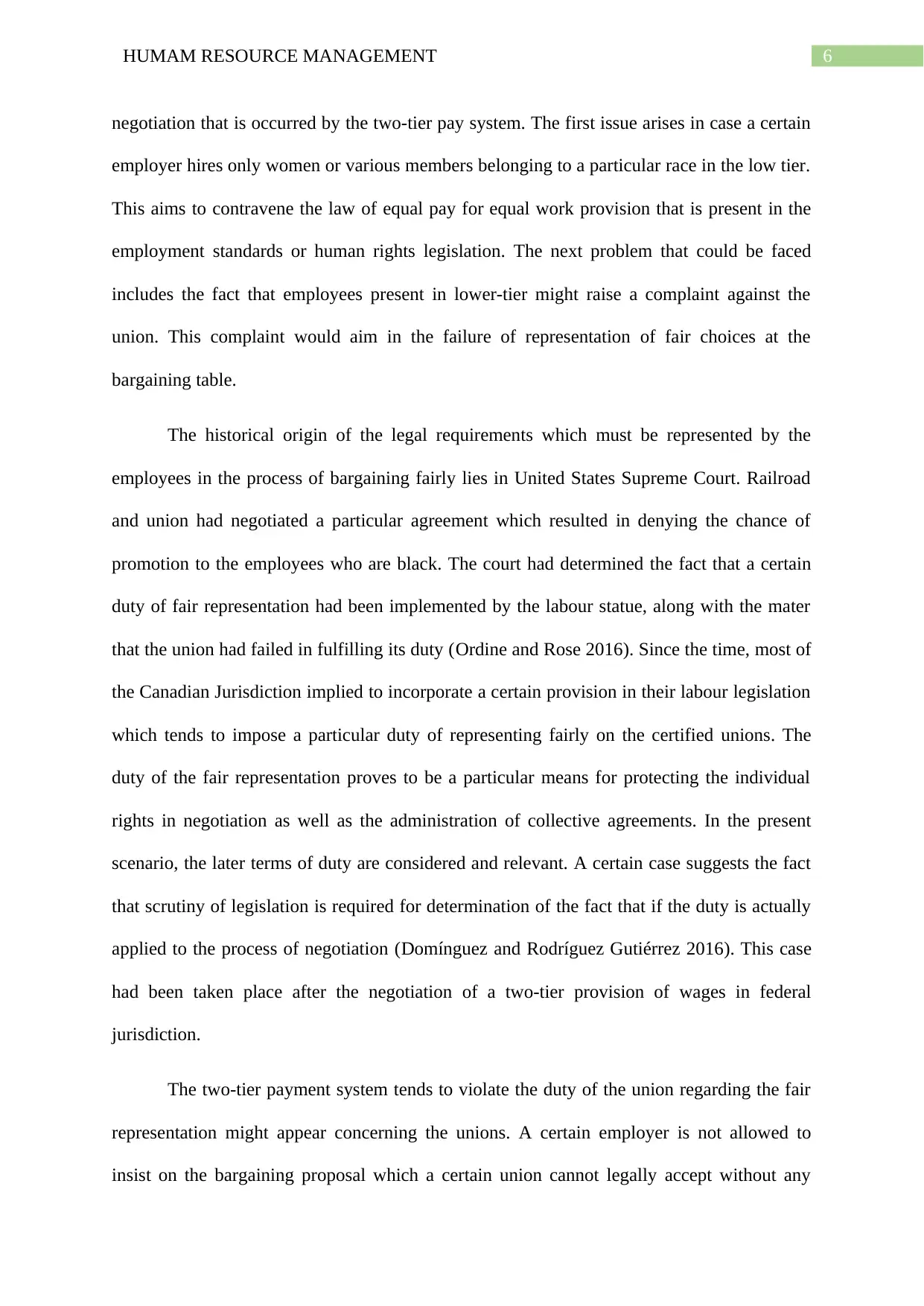
6HUMAM RESOURCE MANAGEMENT
negotiation that is occurred by the two-tier pay system. The first issue arises in case a certain
employer hires only women or various members belonging to a particular race in the low tier.
This aims to contravene the law of equal pay for equal work provision that is present in the
employment standards or human rights legislation. The next problem that could be faced
includes the fact that employees present in lower-tier might raise a complaint against the
union. This complaint would aim in the failure of representation of fair choices at the
bargaining table.
The historical origin of the legal requirements which must be represented by the
employees in the process of bargaining fairly lies in United States Supreme Court. Railroad
and union had negotiated a particular agreement which resulted in denying the chance of
promotion to the employees who are black. The court had determined the fact that a certain
duty of fair representation had been implemented by the labour statue, along with the mater
that the union had failed in fulfilling its duty (Ordine and Rose 2016). Since the time, most of
the Canadian Jurisdiction implied to incorporate a certain provision in their labour legislation
which tends to impose a particular duty of representing fairly on the certified unions. The
duty of the fair representation proves to be a particular means for protecting the individual
rights in negotiation as well as the administration of collective agreements. In the present
scenario, the later terms of duty are considered and relevant. A certain case suggests the fact
that scrutiny of legislation is required for determination of the fact that if the duty is actually
applied to the process of negotiation (Domínguez and Rodríguez Gutiérrez 2016). This case
had been taken place after the negotiation of a two-tier provision of wages in federal
jurisdiction.
The two-tier payment system tends to violate the duty of the union regarding the fair
representation might appear concerning the unions. A certain employer is not allowed to
insist on the bargaining proposal which a certain union cannot legally accept without any
negotiation that is occurred by the two-tier pay system. The first issue arises in case a certain
employer hires only women or various members belonging to a particular race in the low tier.
This aims to contravene the law of equal pay for equal work provision that is present in the
employment standards or human rights legislation. The next problem that could be faced
includes the fact that employees present in lower-tier might raise a complaint against the
union. This complaint would aim in the failure of representation of fair choices at the
bargaining table.
The historical origin of the legal requirements which must be represented by the
employees in the process of bargaining fairly lies in United States Supreme Court. Railroad
and union had negotiated a particular agreement which resulted in denying the chance of
promotion to the employees who are black. The court had determined the fact that a certain
duty of fair representation had been implemented by the labour statue, along with the mater
that the union had failed in fulfilling its duty (Ordine and Rose 2016). Since the time, most of
the Canadian Jurisdiction implied to incorporate a certain provision in their labour legislation
which tends to impose a particular duty of representing fairly on the certified unions. The
duty of the fair representation proves to be a particular means for protecting the individual
rights in negotiation as well as the administration of collective agreements. In the present
scenario, the later terms of duty are considered and relevant. A certain case suggests the fact
that scrutiny of legislation is required for determination of the fact that if the duty is actually
applied to the process of negotiation (Domínguez and Rodríguez Gutiérrez 2016). This case
had been taken place after the negotiation of a two-tier provision of wages in federal
jurisdiction.
The two-tier payment system tends to violate the duty of the union regarding the fair
representation might appear concerning the unions. A certain employer is not allowed to
insist on the bargaining proposal which a certain union cannot legally accept without any
Paraphrase This Document
Need a fresh take? Get an instant paraphrase of this document with our AI Paraphraser
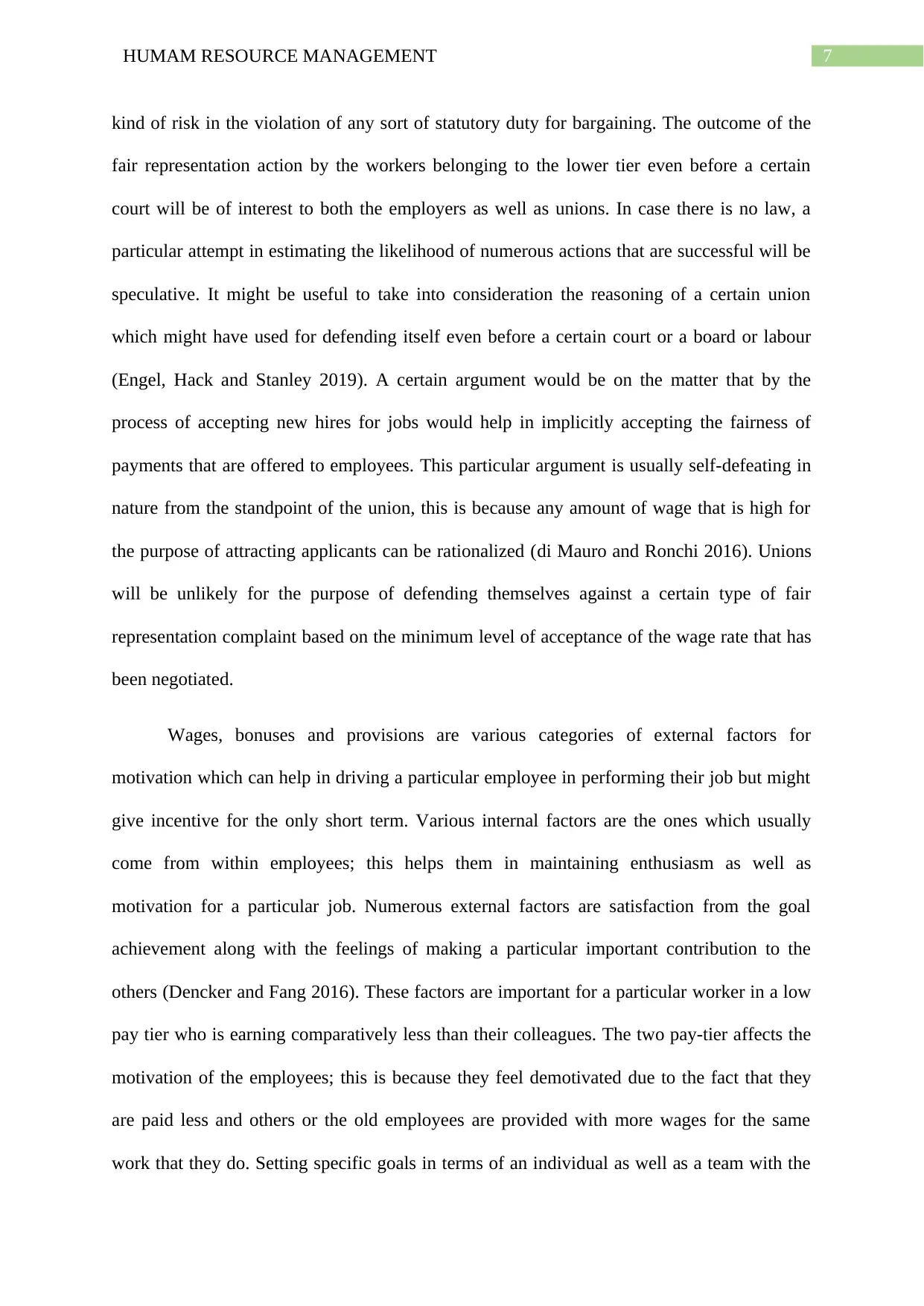
7HUMAM RESOURCE MANAGEMENT
kind of risk in the violation of any sort of statutory duty for bargaining. The outcome of the
fair representation action by the workers belonging to the lower tier even before a certain
court will be of interest to both the employers as well as unions. In case there is no law, a
particular attempt in estimating the likelihood of numerous actions that are successful will be
speculative. It might be useful to take into consideration the reasoning of a certain union
which might have used for defending itself even before a certain court or a board or labour
(Engel, Hack and Stanley 2019). A certain argument would be on the matter that by the
process of accepting new hires for jobs would help in implicitly accepting the fairness of
payments that are offered to employees. This particular argument is usually self-defeating in
nature from the standpoint of the union, this is because any amount of wage that is high for
the purpose of attracting applicants can be rationalized (di Mauro and Ronchi 2016). Unions
will be unlikely for the purpose of defending themselves against a certain type of fair
representation complaint based on the minimum level of acceptance of the wage rate that has
been negotiated.
Wages, bonuses and provisions are various categories of external factors for
motivation which can help in driving a particular employee in performing their job but might
give incentive for the only short term. Various internal factors are the ones which usually
come from within employees; this helps them in maintaining enthusiasm as well as
motivation for a particular job. Numerous external factors are satisfaction from the goal
achievement along with the feelings of making a particular important contribution to the
others (Dencker and Fang 2016). These factors are important for a particular worker in a low
pay tier who is earning comparatively less than their colleagues. The two pay-tier affects the
motivation of the employees; this is because they feel demotivated due to the fact that they
are paid less and others or the old employees are provided with more wages for the same
work that they do. Setting specific goals in terms of an individual as well as a team with the
kind of risk in the violation of any sort of statutory duty for bargaining. The outcome of the
fair representation action by the workers belonging to the lower tier even before a certain
court will be of interest to both the employers as well as unions. In case there is no law, a
particular attempt in estimating the likelihood of numerous actions that are successful will be
speculative. It might be useful to take into consideration the reasoning of a certain union
which might have used for defending itself even before a certain court or a board or labour
(Engel, Hack and Stanley 2019). A certain argument would be on the matter that by the
process of accepting new hires for jobs would help in implicitly accepting the fairness of
payments that are offered to employees. This particular argument is usually self-defeating in
nature from the standpoint of the union, this is because any amount of wage that is high for
the purpose of attracting applicants can be rationalized (di Mauro and Ronchi 2016). Unions
will be unlikely for the purpose of defending themselves against a certain type of fair
representation complaint based on the minimum level of acceptance of the wage rate that has
been negotiated.
Wages, bonuses and provisions are various categories of external factors for
motivation which can help in driving a particular employee in performing their job but might
give incentive for the only short term. Various internal factors are the ones which usually
come from within employees; this helps them in maintaining enthusiasm as well as
motivation for a particular job. Numerous external factors are satisfaction from the goal
achievement along with the feelings of making a particular important contribution to the
others (Dencker and Fang 2016). These factors are important for a particular worker in a low
pay tier who is earning comparatively less than their colleagues. The two pay-tier affects the
motivation of the employees; this is because they feel demotivated due to the fact that they
are paid less and others or the old employees are provided with more wages for the same
work that they do. Setting specific goals in terms of an individual as well as a team with the
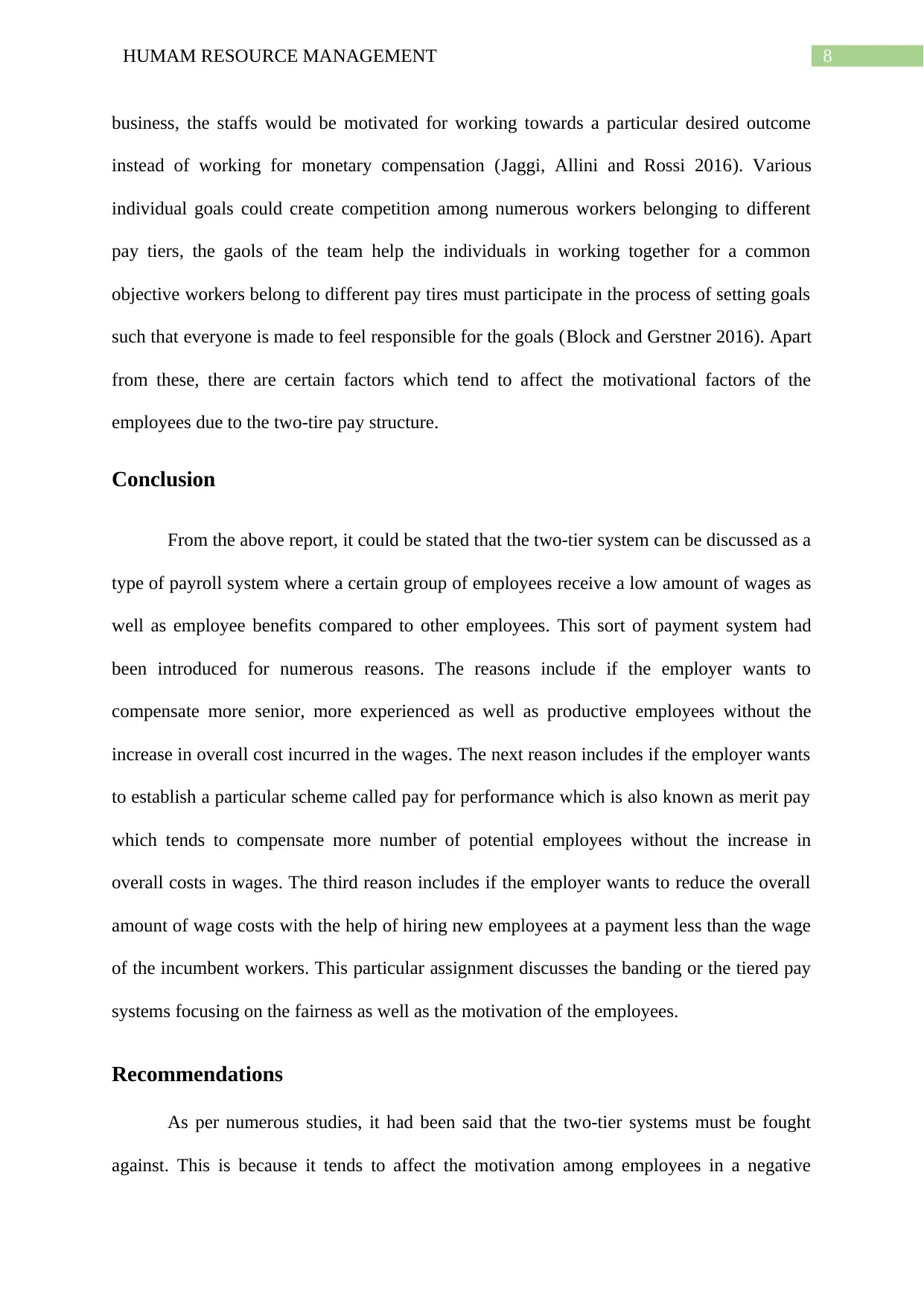
8HUMAM RESOURCE MANAGEMENT
business, the staffs would be motivated for working towards a particular desired outcome
instead of working for monetary compensation (Jaggi, Allini and Rossi 2016). Various
individual goals could create competition among numerous workers belonging to different
pay tiers, the gaols of the team help the individuals in working together for a common
objective workers belong to different pay tires must participate in the process of setting goals
such that everyone is made to feel responsible for the goals (Block and Gerstner 2016). Apart
from these, there are certain factors which tend to affect the motivational factors of the
employees due to the two-tire pay structure.
Conclusion
From the above report, it could be stated that the two-tier system can be discussed as a
type of payroll system where a certain group of employees receive a low amount of wages as
well as employee benefits compared to other employees. This sort of payment system had
been introduced for numerous reasons. The reasons include if the employer wants to
compensate more senior, more experienced as well as productive employees without the
increase in overall cost incurred in the wages. The next reason includes if the employer wants
to establish a particular scheme called pay for performance which is also known as merit pay
which tends to compensate more number of potential employees without the increase in
overall costs in wages. The third reason includes if the employer wants to reduce the overall
amount of wage costs with the help of hiring new employees at a payment less than the wage
of the incumbent workers. This particular assignment discusses the banding or the tiered pay
systems focusing on the fairness as well as the motivation of the employees.
Recommendations
As per numerous studies, it had been said that the two-tier systems must be fought
against. This is because it tends to affect the motivation among employees in a negative
business, the staffs would be motivated for working towards a particular desired outcome
instead of working for monetary compensation (Jaggi, Allini and Rossi 2016). Various
individual goals could create competition among numerous workers belonging to different
pay tiers, the gaols of the team help the individuals in working together for a common
objective workers belong to different pay tires must participate in the process of setting goals
such that everyone is made to feel responsible for the goals (Block and Gerstner 2016). Apart
from these, there are certain factors which tend to affect the motivational factors of the
employees due to the two-tire pay structure.
Conclusion
From the above report, it could be stated that the two-tier system can be discussed as a
type of payroll system where a certain group of employees receive a low amount of wages as
well as employee benefits compared to other employees. This sort of payment system had
been introduced for numerous reasons. The reasons include if the employer wants to
compensate more senior, more experienced as well as productive employees without the
increase in overall cost incurred in the wages. The next reason includes if the employer wants
to establish a particular scheme called pay for performance which is also known as merit pay
which tends to compensate more number of potential employees without the increase in
overall costs in wages. The third reason includes if the employer wants to reduce the overall
amount of wage costs with the help of hiring new employees at a payment less than the wage
of the incumbent workers. This particular assignment discusses the banding or the tiered pay
systems focusing on the fairness as well as the motivation of the employees.
Recommendations
As per numerous studies, it had been said that the two-tier systems must be fought
against. This is because it tends to affect the motivation among employees in a negative
⊘ This is a preview!⊘
Do you want full access?
Subscribe today to unlock all pages.

Trusted by 1+ million students worldwide
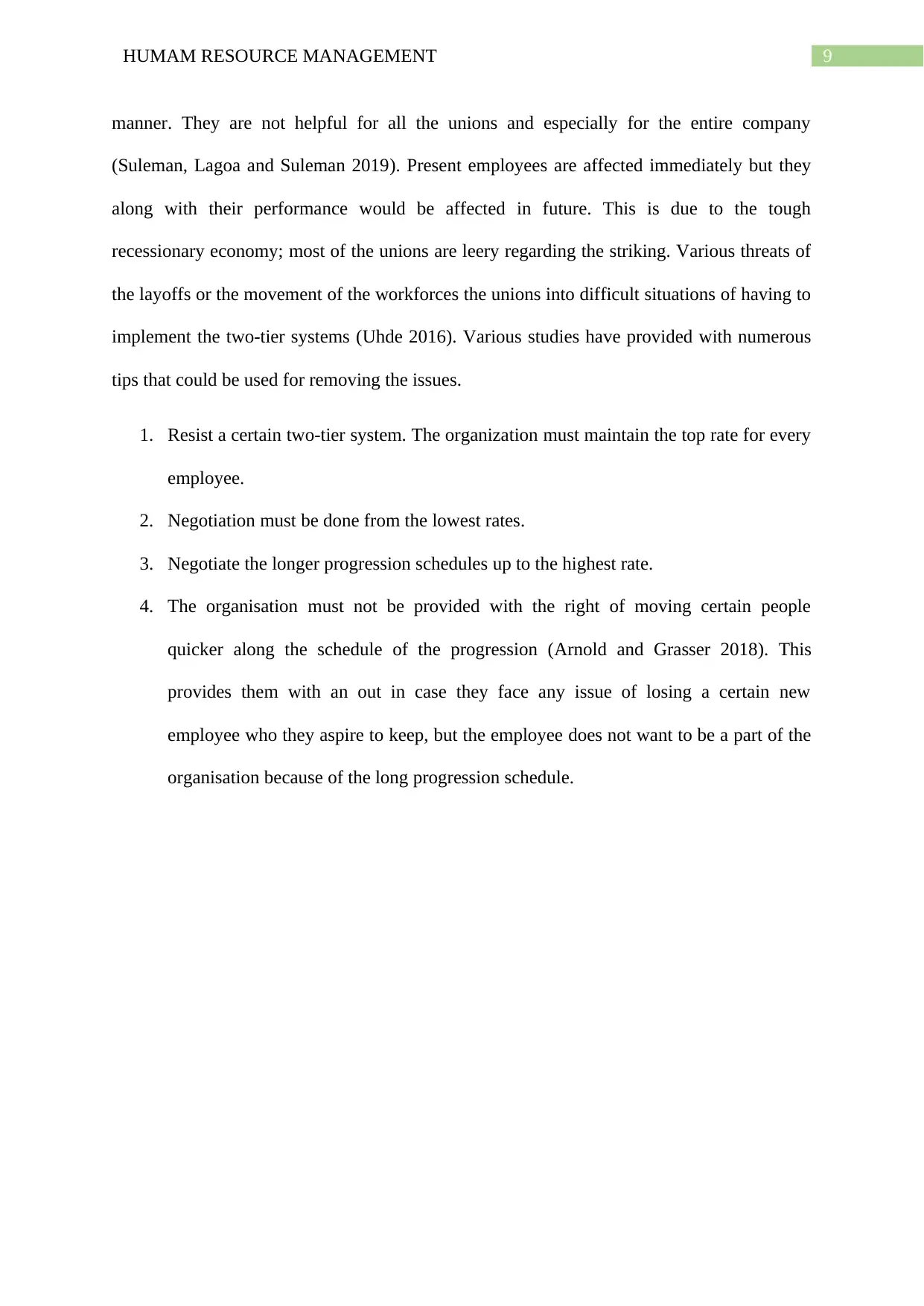
9HUMAM RESOURCE MANAGEMENT
manner. They are not helpful for all the unions and especially for the entire company
(Suleman, Lagoa and Suleman 2019). Present employees are affected immediately but they
along with their performance would be affected in future. This is due to the tough
recessionary economy; most of the unions are leery regarding the striking. Various threats of
the layoffs or the movement of the workforces the unions into difficult situations of having to
implement the two-tier systems (Uhde 2016). Various studies have provided with numerous
tips that could be used for removing the issues.
1. Resist a certain two-tier system. The organization must maintain the top rate for every
employee.
2. Negotiation must be done from the lowest rates.
3. Negotiate the longer progression schedules up to the highest rate.
4. The organisation must not be provided with the right of moving certain people
quicker along the schedule of the progression (Arnold and Grasser 2018). This
provides them with an out in case they face any issue of losing a certain new
employee who they aspire to keep, but the employee does not want to be a part of the
organisation because of the long progression schedule.
manner. They are not helpful for all the unions and especially for the entire company
(Suleman, Lagoa and Suleman 2019). Present employees are affected immediately but they
along with their performance would be affected in future. This is due to the tough
recessionary economy; most of the unions are leery regarding the striking. Various threats of
the layoffs or the movement of the workforces the unions into difficult situations of having to
implement the two-tier systems (Uhde 2016). Various studies have provided with numerous
tips that could be used for removing the issues.
1. Resist a certain two-tier system. The organization must maintain the top rate for every
employee.
2. Negotiation must be done from the lowest rates.
3. Negotiate the longer progression schedules up to the highest rate.
4. The organisation must not be provided with the right of moving certain people
quicker along the schedule of the progression (Arnold and Grasser 2018). This
provides them with an out in case they face any issue of losing a certain new
employee who they aspire to keep, but the employee does not want to be a part of the
organisation because of the long progression schedule.
Paraphrase This Document
Need a fresh take? Get an instant paraphrase of this document with our AI Paraphraser
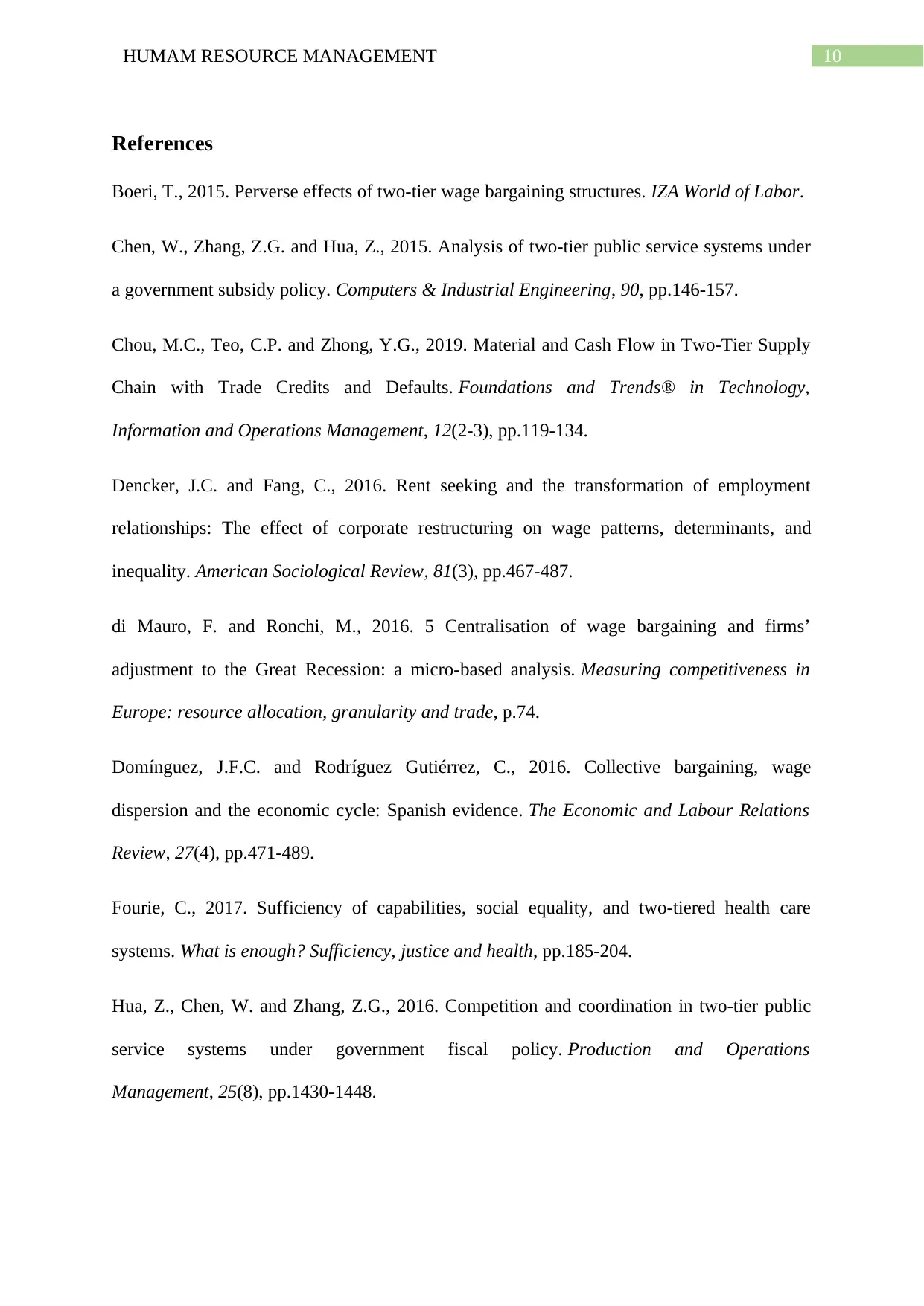
10HUMAM RESOURCE MANAGEMENT
References
Boeri, T., 2015. Perverse effects of two-tier wage bargaining structures. IZA World of Labor.
Chen, W., Zhang, Z.G. and Hua, Z., 2015. Analysis of two-tier public service systems under
a government subsidy policy. Computers & Industrial Engineering, 90, pp.146-157.
Chou, M.C., Teo, C.P. and Zhong, Y.G., 2019. Material and Cash Flow in Two-Tier Supply
Chain with Trade Credits and Defaults. Foundations and Trends® in Technology,
Information and Operations Management, 12(2-3), pp.119-134.
Dencker, J.C. and Fang, C., 2016. Rent seeking and the transformation of employment
relationships: The effect of corporate restructuring on wage patterns, determinants, and
inequality. American Sociological Review, 81(3), pp.467-487.
di Mauro, F. and Ronchi, M., 2016. 5 Centralisation of wage bargaining and firms’
adjustment to the Great Recession: a micro-based analysis. Measuring competitiveness in
Europe: resource allocation, granularity and trade, p.74.
Domínguez, J.F.C. and Rodríguez Gutiérrez, C., 2016. Collective bargaining, wage
dispersion and the economic cycle: Spanish evidence. The Economic and Labour Relations
Review, 27(4), pp.471-489.
Fourie, C., 2017. Sufficiency of capabilities, social equality, and two-tiered health care
systems. What is enough? Sufficiency, justice and health, pp.185-204.
Hua, Z., Chen, W. and Zhang, Z.G., 2016. Competition and coordination in two‐tier public
service systems under government fiscal policy. Production and Operations
Management, 25(8), pp.1430-1448.
References
Boeri, T., 2015. Perverse effects of two-tier wage bargaining structures. IZA World of Labor.
Chen, W., Zhang, Z.G. and Hua, Z., 2015. Analysis of two-tier public service systems under
a government subsidy policy. Computers & Industrial Engineering, 90, pp.146-157.
Chou, M.C., Teo, C.P. and Zhong, Y.G., 2019. Material and Cash Flow in Two-Tier Supply
Chain with Trade Credits and Defaults. Foundations and Trends® in Technology,
Information and Operations Management, 12(2-3), pp.119-134.
Dencker, J.C. and Fang, C., 2016. Rent seeking and the transformation of employment
relationships: The effect of corporate restructuring on wage patterns, determinants, and
inequality. American Sociological Review, 81(3), pp.467-487.
di Mauro, F. and Ronchi, M., 2016. 5 Centralisation of wage bargaining and firms’
adjustment to the Great Recession: a micro-based analysis. Measuring competitiveness in
Europe: resource allocation, granularity and trade, p.74.
Domínguez, J.F.C. and Rodríguez Gutiérrez, C., 2016. Collective bargaining, wage
dispersion and the economic cycle: Spanish evidence. The Economic and Labour Relations
Review, 27(4), pp.471-489.
Fourie, C., 2017. Sufficiency of capabilities, social equality, and two-tiered health care
systems. What is enough? Sufficiency, justice and health, pp.185-204.
Hua, Z., Chen, W. and Zhang, Z.G., 2016. Competition and coordination in two‐tier public
service systems under government fiscal policy. Production and Operations
Management, 25(8), pp.1430-1448.
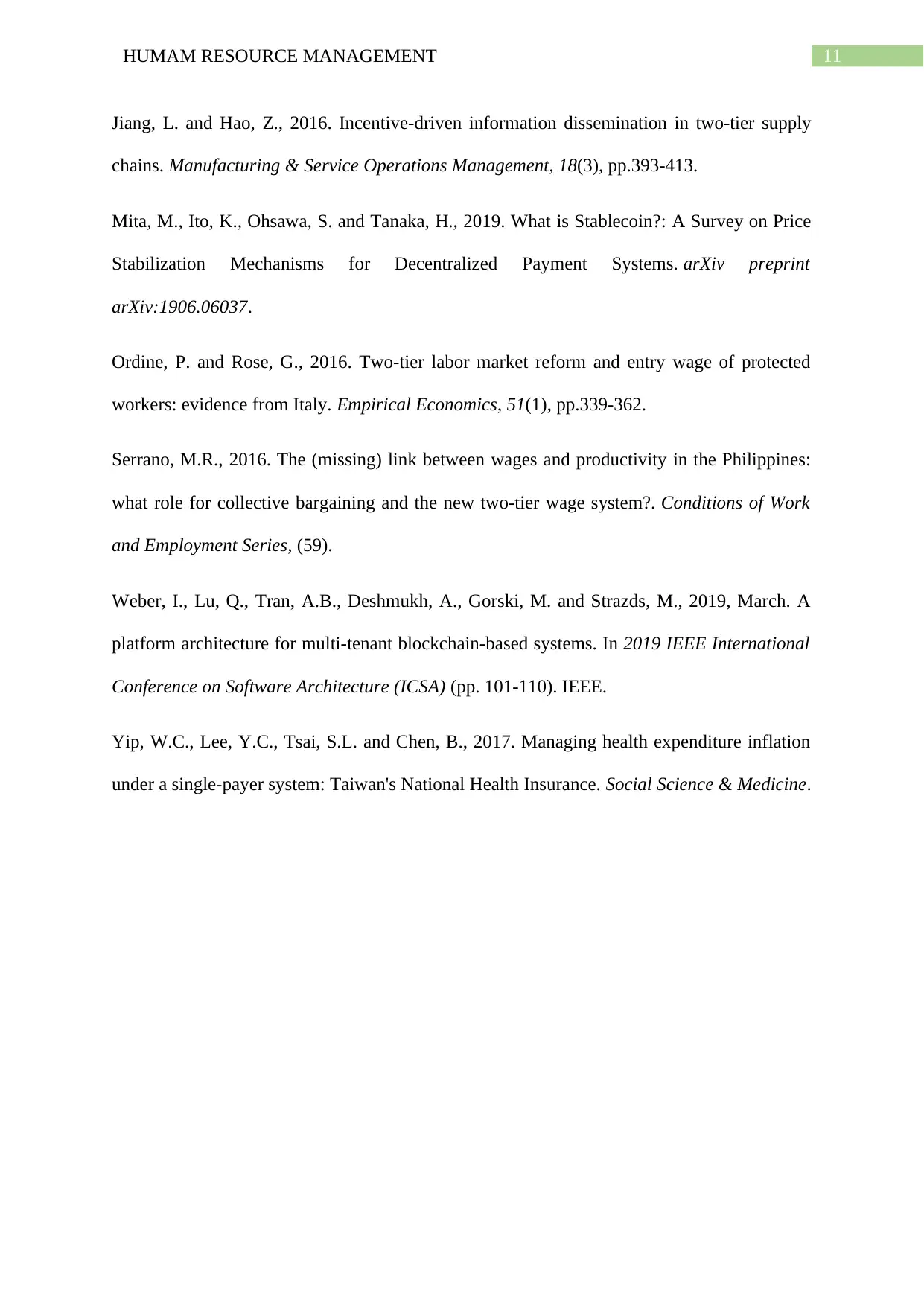
11HUMAM RESOURCE MANAGEMENT
Jiang, L. and Hao, Z., 2016. Incentive-driven information dissemination in two-tier supply
chains. Manufacturing & Service Operations Management, 18(3), pp.393-413.
Mita, M., Ito, K., Ohsawa, S. and Tanaka, H., 2019. What is Stablecoin?: A Survey on Price
Stabilization Mechanisms for Decentralized Payment Systems. arXiv preprint
arXiv:1906.06037.
Ordine, P. and Rose, G., 2016. Two-tier labor market reform and entry wage of protected
workers: evidence from Italy. Empirical Economics, 51(1), pp.339-362.
Serrano, M.R., 2016. The (missing) link between wages and productivity in the Philippines:
what role for collective bargaining and the new two-tier wage system?. Conditions of Work
and Employment Series, (59).
Weber, I., Lu, Q., Tran, A.B., Deshmukh, A., Gorski, M. and Strazds, M., 2019, March. A
platform architecture for multi-tenant blockchain-based systems. In 2019 IEEE International
Conference on Software Architecture (ICSA) (pp. 101-110). IEEE.
Yip, W.C., Lee, Y.C., Tsai, S.L. and Chen, B., 2017. Managing health expenditure inflation
under a single-payer system: Taiwan's National Health Insurance. Social Science & Medicine.
Jiang, L. and Hao, Z., 2016. Incentive-driven information dissemination in two-tier supply
chains. Manufacturing & Service Operations Management, 18(3), pp.393-413.
Mita, M., Ito, K., Ohsawa, S. and Tanaka, H., 2019. What is Stablecoin?: A Survey on Price
Stabilization Mechanisms for Decentralized Payment Systems. arXiv preprint
arXiv:1906.06037.
Ordine, P. and Rose, G., 2016. Two-tier labor market reform and entry wage of protected
workers: evidence from Italy. Empirical Economics, 51(1), pp.339-362.
Serrano, M.R., 2016. The (missing) link between wages and productivity in the Philippines:
what role for collective bargaining and the new two-tier wage system?. Conditions of Work
and Employment Series, (59).
Weber, I., Lu, Q., Tran, A.B., Deshmukh, A., Gorski, M. and Strazds, M., 2019, March. A
platform architecture for multi-tenant blockchain-based systems. In 2019 IEEE International
Conference on Software Architecture (ICSA) (pp. 101-110). IEEE.
Yip, W.C., Lee, Y.C., Tsai, S.L. and Chen, B., 2017. Managing health expenditure inflation
under a single-payer system: Taiwan's National Health Insurance. Social Science & Medicine.
⊘ This is a preview!⊘
Do you want full access?
Subscribe today to unlock all pages.

Trusted by 1+ million students worldwide
1 out of 12
Related Documents
Your All-in-One AI-Powered Toolkit for Academic Success.
+13062052269
info@desklib.com
Available 24*7 on WhatsApp / Email
![[object Object]](/_next/static/media/star-bottom.7253800d.svg)
Unlock your academic potential
Copyright © 2020–2025 A2Z Services. All Rights Reserved. Developed and managed by ZUCOL.




